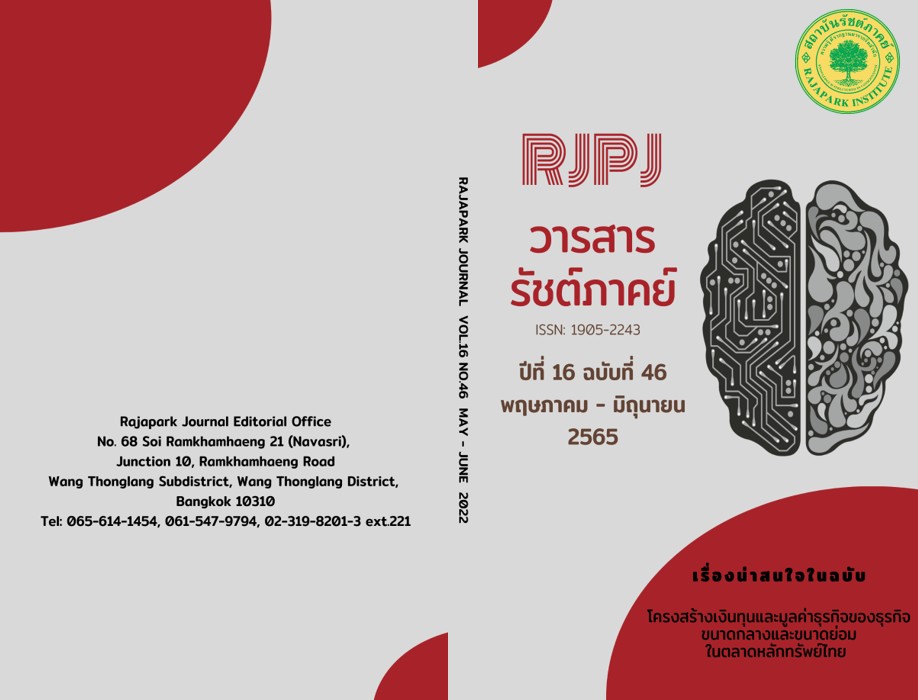The Model of COVID-19 Prevention in the Critical Situations of Thai Society
Main Article Content
Abstract
The purposes of this research were: (1) to study the negative impacts of the COVID-19 pandemic; (2) to study the practices used to prevent the COVID-19 pandemic; and (3) to present the model of COVID-19 prevention in the critical situations of Thai society. A mixed-research methodology was applied in this study. The samples used in this study were 350 people and five key informants who are university personnel in Bangkok and suburban areas. The instruments used to collect data were a research questionnaire and an in-depth interview. The statistics used in this research consisted of percentage, mean, and standard deviation. The research results showed that: (1) the negative impacts of the COVID-19 pandemic, in total, were at a high level. In particular, the negative impacts on human life had the highest mean value, followed by business, happiness, and work respectively; (2) the practices used to prevent the COVID-19 pandemic, in total, were at a high level. In particular, mask wearing had the highest mean value, followed by social distancing, vaccine vaccination, and hand washing respectively; and (3) the model of COVID-19 prevention in the critical situations of Thai society consisted of being aware of the COVID-19, understanding the causes of the COVID-19, understanding the impacts of the COVID-19, applying preventive approaches, mask wearing, social distancing, hand washing, refraining from traveling to risky places, vaccine vaccination, creating morale and courage, and having a good planning.
Article Details

This work is licensed under a Creative Commons Attribution-NonCommercial-NoDerivatives 4.0 International License.
Views and opinions appearing in the Journal it is the responsibility of the author of the article, and does not constitute the view and responsibility of the editorial team.
References
Bangkokbiznews. (April 28, 2020). The Who Has Warned That the COVID-19 Outbreak Will Not Be Over Soon. Bangkokbiznews. https://www.bangkokbiznews.com/world/878146
BBC News. (May 4, 2020). COVOD-19: Origin, Symptom, Treatment and Prevention. BBC News. https://www.bbc.com.
Brown, H., & Nading, A. (2019). Introduction: Human Health in Medical Anthropology. Medical Anthropology Quarterly, 33(1), 5-23. https://doi.org/10.1111/maq.12488
Ciotti, M., Ciccozzi, M., Terrinoni, A., Jiang, W.C., Wang, C.B., & Bernadini, S. (2020). The COVID-19 Pandemic. Critical Reviews in Clinical Laboratory Sciences, 57(6), 365-388. DOI: 10.1080/10408363.2020.1783198
De Los Santos, J.A.A., & Labraque, L.J. (2021). The Impact of Fear of COVID-19 on Job Stress, and Turnover Intentions of Frontline Nurses in the Community: A Cross-sectional Study in the Philippines. Traumatology, 27(1), 52-59. https://doi.org/10.1037/trm0000294
Jungsathiensap, K. (2020). Anthropology and Epidemic: COVID-19, Emerging Disease and Anthropology Research. Sirindhorn Anthropology Center.
Keadplang, K. (2021). Applying Constructive Alignment through 30s Platforms for Graduate Students During COVID-19 in Thailand: English for Events and Exhibitions Course (ESP). Rajapark Journal, 15(43), 25-37.
Ketdao, R., Thiengtrongdee, A., & Thoin, P. (2021). Development of Model of COVID-19 Surveillance Prevention and Control Promoting Health Hospital in Sub-district Level, Udonthani Province-Udon Model COVID-19. Journal of Health Science, 30(1), 53-61.
Leela-Adisorn, N. (2021). Impact of Coronavirus Disease 2019 (COVID-19) Epidemic on Dental Work. Journal of Health Science, 30(3), 404-411.
Nguyen, V. (2017). Viral Speed: Infrastructure, Connectivity, Ontogeny; or Notes on the Molecular Epidemiology of Epidemics. Cultural Anthropology, 32(1), 28-34. DOI: 10.14506/ca32.1.04
Phrakhrusripariyativitan (Phramaha Maen Kuppatarangsi/Thongvijit). (2020). The Attitudes of People Towards the Prevention and Treatment of Coronavirus COVID-19 According to the Four Noble Truths. Journal of Arts Management, 4(3), 521-536.
Puekpuang. P. (2018). Distribution of Infectious Diseases in Health Data System by Dasymmetric Mapping. Journal of Health Systems Research, 12(3), 480-489.
Qiu, W., Rutherfeld, S., Mao, A., & Chu, C. (2017). The Pandemic and Its Impact. Health, Culture, and Society, 10(1), 1-11. https://doi.org/10.5195/hcs.2017.221
Rothan. H.A., & Byrareddy, S.N. (2020). The Epidemiology and Pathogenesis of Coronavirus Disease (COVID-19) Outbreak. Journal of Autoimmunity, 109(1), 1-4. DOI: 10.1016/j.jaut.2020.102433
Setkhumbong, T. (2022). Changing the Learning Environment in Higher Education to the Normal in the COVID-19 Crisis Situation. Rajapark Journal, 15(44), 1-13.
Sombultawee, K., Boon-Itt, S., & Bussanit, V. (2021). The Adoption of Protective Health Behavior During the COVID-19 Pandemic in Thailand. The Journal of Behavioral Science (TIBS), 16(3), 72-83.
Wongwassana, S. (2021). Negative Influential Factors from COVID-19 Pandemic on Passenger Service’s Happiness in Work: A Case Study of Bangkok Flight Services (BFT). Rajapark Journal, 15(39), 15-30.
World Health Organization [WHO]. (2021). WHO Coronavirus (COVID-19) Dashboard. WHO. https://covid19.who.int.
World Health Organization [WHO]. (2021). Advice for the Public: Coronavirus Disease (COVID-19). WHO. https://www.who.int/emergencies/deseases/novel-coronavirus-2019/advice-for-public


